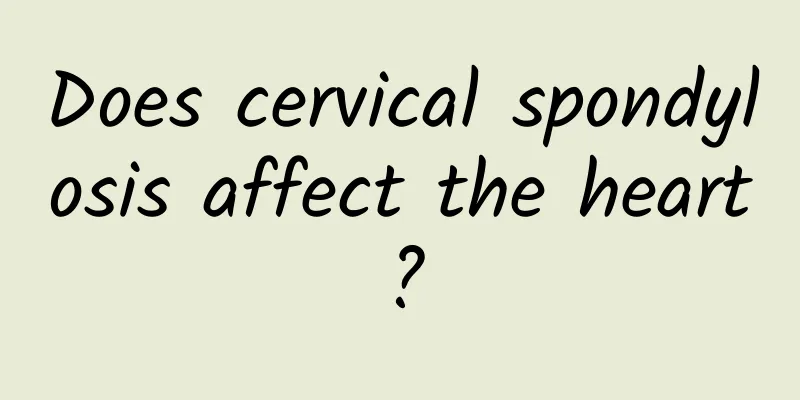What are the causes and clinical manifestations of peripheral facial nerve palsy?

|
Peripheral facial nerve paralysis is a disease in which the facial expression muscles on one or both sides are paralyzed, resulting in the inability to frown, frown, close eyes, show teeth, or puff cheeks on the affected side. So what are the causes and mechanisms of this disease? 1. Causes and mechanisms The cause of peripheral facial nerve paralysis is unknown. It is often seen in people who catch cold after extreme fatigue and is related to cold, ischemia, and decreased immunity. The facial nerve must pass through a narrow bony canal when passing through the skull, also called the facial nerve canal. The narrow facial nerve canal is an internal factor that makes the facial nerve easily affected. In addition, because the facial nerve is located superficially on the face and is very close to the pharynx, it is easily invaded by cold wind, and the soft tissue around the facial nerve proliferates, adheres and hardens, and the local nutrient blood vessels spasm, leading to ischemia, hypoxia and edema of the facial nerve, which becomes an external factor that makes the facial nerve easily affected. The specific pathological changes are: spasm and ischemia of the facial nerve nutrition blood vessels in the facial nerve canal, leading to facial nerve edema and demyelination. In the early stages, it is mostly reversible neuropathy, while in severe cases, axonal degeneration or complete nerve damage occurs. 2. Clinical manifestations It is paralysis of the upper and lower facial muscles on the same side, that is, the forehead wrinkles on the affected side become shallow or disappear, the eyebrows cannot be frowned, the palpebral fissure becomes larger, and the eyelids are unable to close. When the eyes are closed forcefully, the eyeballs roll upward and outward, exposing the white sclera, which is called Bell's sign. The nasolabial groove on the affected side becomes shallower, the corner of the mouth droops, the cheek is puffed up and air leaks, the person cannot whistle, and food remains between the cheek and gums when eating. In the case of peripheral facial nerve paralysis, the specific location of the lesion can be further determined based on the associated symptoms and signs. 1. Damage to the facial nerve nucleus: In addition to peripheral facial nerve paralysis, it is often accompanied by abducens nerve paralysis, contralateral pyramidal tract signs, and lesions in the pons. Common in brainstem tumors and vascular diseases. 2. Geniculate ganglion damage: manifested as peripheral facial nerve paralysis, severe pain behind the ear, herpes on the tympanic membrane and external auditory canal, and may be accompanied by taste disorders in the anterior 2/3 of the tongue and secretion disorders of the lacrimal and salivary glands, which is called Hunt syndrome. Seen in geniculate ganglion herpes zoster virus infection. 3. Damage within the facial nerve canal: Peripheral facial nerve paralysis is accompanied by taste disorders in the anterior 2/3 of the tongue and salivary gland secretion disorders. This is due to the involvement of the chorda tympani nerve within the facial nerve canal. If it is also accompanied by hyperacusis, the lesions are mostly above the stapedial nerve. 4. Lesions outside the stylomastoid foramen: only peripheral facial nerve paralysis occurs. To diagnose facial nerve paralysis, we must first distinguish whether it is peripheral facial nerve paralysis or central facial nerve paralysis. If it is peripheral facial nerve palsy, it is also necessary to distinguish whether it is inside or outside the brainstem. Effective treatment is only possible if the disease is located clearly. 3. Onset and Self-Healing Peripheral facial nerve paralysis is most common in patients aged 15-45 years old, but it can occur at any age, with no gender or seasonal differences in its onset. In addition to typical peripheral facial nerve paralysis, there are also varying degrees of tearing, pain behind the ear, loss of taste, dry eyes or hyperacusis. The disease usually develops within a few hours or reaches a peak within 1-3 days. 85% of patients begin to recover within 3 weeks after onset, 15% of patients begin to recover within 3-5 months after onset, and 2/3 of patients can fully return to normal within 3 months. The study found that after one year, 71% of patients were able to fully recover, 29% partially recovered, of which 17% had facial spasm, 16% had synkinesis of facial muscles, and 2% had dry eyes or tears. Studies have shown that the natural recovery rate decreases with age after the age of 45, and only one-third of patients over 60 can recover completely. Peripheral facial nerve paralysis is a systemic disease. The more severe the clinical symptoms, the older the age, the worse the physical condition, the insufficient qi and blood, and the poor immunity, the worse the prognosis, and treatment should be intervened as early as possible. IV. Treatment Principles of treatment: Promote early resolution of local inflammation and edema, and promote recovery of nerve function. Specific methods: First, for the most common viral infection after fatigue, antiviral, nerve nutrition, glucocorticoids, B vitamins and other drugs can be used; second, minimally invasive release surgery can be used to loosen the hyperplasia, adhesion and sclerosis of local soft tissue, relieve the pressure on the facial nerve, improve local microcirculation, and promote the recovery of facial nerve function; third, to protect the exposed cornea and prevent conjunctivitis, eye masks, eye drops, eye ointments, etc. can be used; fourth, the patient can massage the facial muscles of facial paralysis with his hands in front of the mirror to promote local blood circulation, several times a day, each time for 5 to 10 minutes. |
<<: What are the causes of PCOS?
>>: Blood-replenishing porridge for women, drink it to make them look good!
Recommend
How to remove the thorns on the feet
A cornea is a skin problem caused by friction and...
Direct bilirubin 10
Various examinations will be done if there is a p...
Symptoms of viral myocarditis, teach you how to judge
Many diseases have similar symptoms, and misdiagn...
How to reduce facial swelling
No one wants to see facial swelling, because faci...
Chest tightness, nausea and vomiting
When it comes to the symptoms of chest tightness,...
Symptoms of spastic cerebral palsy in children
Spastic cerebral palsy in children is caused by t...
Are hemorrhoids contagious?
Is hemorrhoids contagious? Many friends are afrai...
Why does a child sweat on his head?
If a child sweats on his head while sleeping, par...
Why does it hurt when I urinate?
Pain when urinating is most likely due to a urina...
Note: Half a month after ultrasonic scalpel surgery
Ultrasonic knife is a relatively common beauty me...
The efficacy, function and edible method of Toad Grass
Toad grass mainly has the effect of promoting dam...
Can pregnant women drink iced mineral water?
It is very beneficial for pregnant women to drink...
What is the best medicine for anxiety and insomnia?
Insomnia is quite common in our daily life. There...
What part of the body do the lips correspond to?
Some abnormalities of the lips also correspond to...
Why is my hair numb?
A numb tongue can actually make people feel very ...









